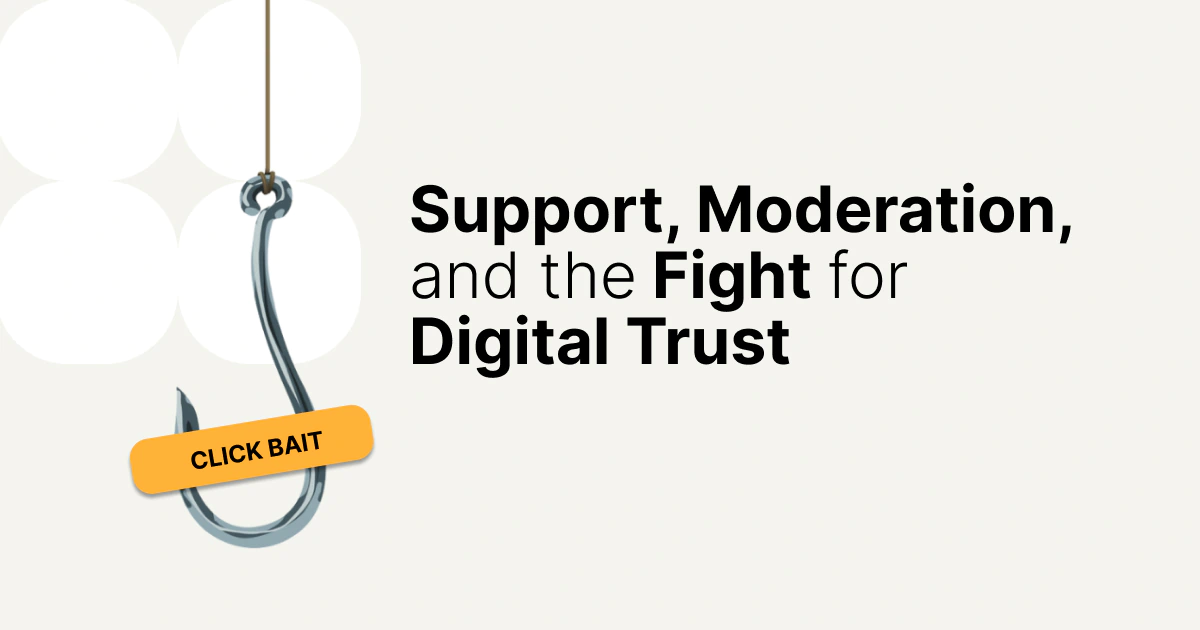Online media platforms, from news publishers to streaming sites, have more attention and expectations than ever before. Audiences want safe, reliable spaces where they can connect, read, or stream without wading through noise. Advertisers want guarantees that their brands won’t be placed next to toxic or irrelevant content. Regulators are watching with new rules that demand proof, not promises.
At the center of all this sits customer support and moderation. They’re the safety net, the trust-builders, the first responders when things go sideways. And today, they’re tasked with managing more than ticket queues or community disputes.
AI Content Flood & Brand Safety
The flood of low-quality AI content is ramping up. NewsGuard has already flagged more than 1,000 AI-run “news” sites churning out clickbait. The problem with this content isn’t about whether or not it’s made by humans. Rather, the concern lies in the fact that it exists to artificially inflate views, siphon traffic, and claim ad revenue, even when the content doesn’t actually promote any platform engagement. It’s a way to try to game the system, using AI as a tool to automate that process.
This kind of abuse of the system turns off advertisers, as they’re no longer confident that they’re ads are being shown to the right audience or on content that’s actually relevant to their prospects.
The issue compounds when these automated content mills lean into sensationalism to get the most clicks and views. As they ramp up aggressive, controversial, and hostile content, it creates a brand safety crisis. Advertisers don’t want their ads showing up next to that kind of content. Historically, a lack of regulation on media and internet platforms has led to mass pullbacks from advertisers, plummeting revenue for large social media organizations as they scramble to catch up
Regulation & Compliance
The rules are tightening, not loosening. Governments are watching media platforms more closely than ever, and penalties for non-compliance hit quickly. The EU’s Digital Services Act (DSA) and the UK’s Online Safety Act have turned moderation into a legal requirement. Every moderation action now requires an audit trail that shows what happened, who handled it, and how it was resolved. Platforms must publish risk assessments, prove their safeguards actually work, and protect minors, with documented proof for all of it.
In practice, this means moderation decisions have to stand up under scrutiny. Workflows need to capture data, escalation paths need to be airtight, and moderators need to understand both the community and the regulatory environment they’re working in. A missing safeguard can mean fines, lawsuits, and regulatory investigations. That’s a cost that goes beyond PR.
Real-Time Moderation at Scale
If you’ve ever watched chat scroll by during a Twitch stream of a global event, you know what chaos looks like. Millions of messages fly by in seconds—jokes, reactions, arguments, and, unfortunately, harassment. Platforms like Twitch and YouTube Live are trying to moderate firehoses of data.
Automation helps, but it’s far from perfect. A keyword filter might catch obvious violations, but it stumbles the moment language gets nuanced. That’s especially true in multilingual spaces where slang, abbreviations, or cultural context can flip meaning entirely. A phrase that’s harmless in one language can be deeply offensive in another. And while the bots sort it out, the chat keeps moving.
We often see this during international broadcasts, from sports to reality TV premieres. As political controversies unfolded mid-broadcast, misinformation and heated debates erupted in real time and spilled across platforms. Automated systems flagged some of it, missed a lot of it, and left human moderators racing to restore order. Viewers, sponsors, and broadcasters all felt the sting.
Businesses hosting live content are faced with the challenge of balancing high-quality moderation and rapid response, requiring precise workflows with a mix of expert intervention and automated systems.
Turning Challenges Into a Playbook for Trust
The pressure on media and internet platforms can feel relentless. AI content mills flood feeds, compliance rules tighten by the month, and live engagement moves faster than most systems can track.
Customer support and moderation now sit at the heart of the business. They’re what keep revenue steady, communities healthy, and credibility intact.
That’s why we’ve put together a full guide to walk media leaders through these challenges. Think audit-ready workflows, surge plans for live events, and tested strategies that help platforms stay compliant without losing the community. It’s a playbook for staying ahead while everyone else scrambles to keep up.



